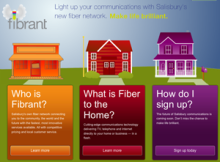After
focusing on the North Carolina battle at the Legislature (regarding whether cities should be allowed to choose to build their own broadband networks or if they should solely have to beg the private sector for investment), I wanted to check in on Salisbury, which is building a FTTH network.
Salisbury has persevered through many obstacles, including finding financing for the project in the midst of the worst economic downturn since the Depression. They will begin serving customers this August.
After choosing the name "Fibrant" as the name of the network, they have
established a slick web presence at fibrant.com. The site has a a blog, but is rarely updated currently.
Earlier in the month, the
local paper discussed the ways in which the fiber network will aid public safety. The short answer is video, video, video.
Video can be used for security cameras (both in public places and in private homes) as well as to give officers better situational awareness when they arrive on a scene. But wireless video access is often the key - both so officers can stream video in the cruiser and because wireless video cameras are easier to place (no pesky wires to run) and move around.
Though wireless video is helpful, it creates of a lot of data that is best moved across fast, reliable, wired networks. This is why fiber-optic networks and wireless are better understood as complements than substitutes. A robust fiber architecture greatly eases the problems incurred by creating a wireless network because the wireless nodes will be more efficient if all are tied into a fiber network. Rather than streaming data across the entire city to send a single feed to a cruiser, a local access point will stream it across a smaller footprint.
"They are potentially looking at helmet cams," Doug Paris said, assistant to the city manager. "Those who are sitting outside (the structure) will be able to see what's going on inside."
It would make little sense for the fireman to have wires coming out of their helmets. But that wireless signal from the helmet probably won't propagate to the fire hall or police station. Instead, a wireless access point near the fire can grab the signal and make it available to anyone who needs access to it.






